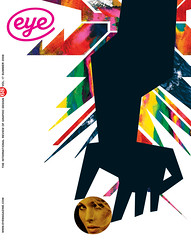Summer 2008
Motomichi Nakamura
Who cares about graphic design history?
Motomichi Nakamura was born in Japan and graduated from New York’s Parsons School of Design in 1996.
Q1. What do you think is meant by ‘the canon of graphic design history’? Do you ever think about it, or buy design history publications?
A1. All the movements that are representative of different periods in design history are in the canon because they represent a type of universal visual language that always remains current.
The history of design is not something I keep in mind usually, and
I don’t buy such publications often, but I do look at certain movements from the past to find out how they resolved visual issues – that helps me when I feel stuck.
Q2. Does this kind of design history have relevance to what you do in your design practice?
A2. Yes, I think design history has always been a way to resolve problems posed by ever-changing media, cultural attitudes and other external factors. Seeing how designers in the past have adapted can be inspiring at a time when we have to deal with media that are completely new and still developing.
Q3. Where did you learn about design history (if at all)?
A3. At Parsons School of Design I took art and design history classes.
Q4. Does history have any relevance to the new technology and techniques you’ve had to master in your work?
A4. I think history has relevance to my work in the sense that the purpose of design always remains similar despite the changes in media and technology and in that sense you can always apply design principles no matter how different a new technology is. Having a solid design foundation gives coherence to visual work regardless of the types of media and technology used to create it.
Q5. If you were in charge of a design education programme, what aspects of design history (if any) would you teach to your students?
A5. It is important for designers to understand the connection between conceptualisation and execution.
I think the most successful design movements in history demonstrate that a combination of both is needed to communicate a visual message effectively, so designers to learn how to develop their ideas to their full extent both conceptually and visually.
First published in Eye no. 68 vol. 17 2008
Eye is the world’s most beautiful and collectable graphic design journal, published quarterly for professional designers, students and anyone interested in critical, informed writing about graphic design and visual culture. It is available from all good design bookshops and online at the Eye shop, where you can buy subscriptions and single issues.

